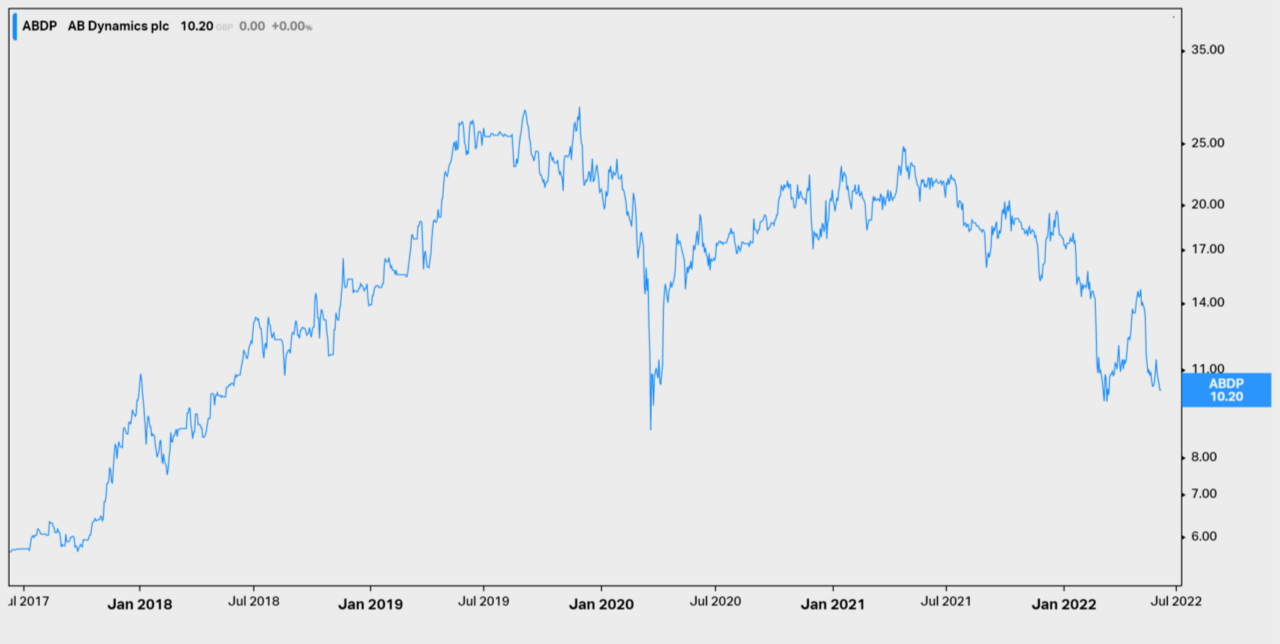Stock Alert: the future of driving lies in the hands of whom?…
9th June 2022 |
Did you know?
Around 1.3 million people die in car accidents worldwide every year.
That’s an incredible 3,287 deaths a day.
Human fallibility is often the reason for road fatalities. This includes drunk driving, tiredness and driver distractions.
This brings a need to develop vehicles that mitigate human error as much as possible, and ultimately reduce the number of road accidents.
After all, car accidents can not only cost people’s lives: they also possibly generate huge financial and reputational costs to the car manufacturer.
With so much on the line, car testing is understandably a crucial procedure for any car manufacturer.
Car testing is when a vehicle’s features are checked in intensive trial periods before commercial use.
Car testing is subject to stringent legislation from regulatory bodies.
In Europe, independent car testing is governed by the European New Car Assessment Programme (Euro NCAP), which assesses the safety performance of new vehicles in Europe.
Legal safety standards are enforced by the EU General Safety Regulation.
Testing, testing…
The automotive industry is undergoing rapid transformational change.
For example, since 2014, Euro NCAP has added more complex, challenging scenarios to vehicle assessments, increasing the number of test runs (per vehicle) by 600% up until 2020.
In 2020, 263 test runs were completed over 39 different vehicle scenarios, compared to only six scenarios and 44 test runs in 2014.
As vehicles become even more technologically advanced, this figure will likely proliferate, and create even greater demand for reliable testing services.
However, navigating through arduous, chaotic testing periods is not easy, and involves huge costs to the manufacturer. For example, crash testing can leave massive damage on a car, meaning that the manufacturer has to keep using (and wasting) new models. Even keeping up with the ever-changing regulatory landscape is a challenge.
Also, failure to reach safety standards can lead to models of that particular vehicle being recalled, putting a greater squeeze on cost bases in a fiercely competitive market.
This has created a huge opportunity has emerged for automotive testing companies who make testing phases easier than ever.
The answer to road safety?
Since its launch in 1997, Euro NCAP estimates that it has saved 78,000 lives. It has crash tested more than 1,800 cars and spent more than €160 million on making cars safer.
Within its testing protocols, Euro NCAP ensures no stone is left unturned when it comes to vehicle safety.
Its testing capabilities include crash testing, automated emergency braking and electronic stability controls.
In this video, you can see how far Euro NCAP has come in terms of improving car safety. Back in the late 1990s, a front-on collision at 40mph would blow a car to smithereens. Now, the impact is far less, helping improve driver safety.
To get to this stage, hours of research and testing were needed to create a vehicle capable of sustaining the impact.
So, what relevance does this have to your latest Frontier Tech Investor recommendation?
Although Euro NCAP claims to have saved tens of thousands of lives, the credit really is due to a revolutionary provider of automotive testing services.
For many years, it has been the partner of choice for not only Euro NCAP, but also a number of household-name automotive manufacturers.
This company has a huge part to play in maintaining safety standards amongst a new generation of vehicles, which are flooding on to our roads as we speak.
Introducing your latest Frontier Tech Investor recommendation…
AB Dynamics (LSE: ABDP) is a provider of automotive testing systems.
It has a market cap of £231.922 million and a current share price of 1,025GBp
It is an AIM-listed company on the London Stock Exchange.
AB Dynamics was founded in 1982 by vehicle enthusiast Anthony Best.
The company started off as a vehicle engineering consultancy, supplying noise, vibration and engineering products for the automotive industry.
AB Dynamics has since grown into a global supplier of advanced automotive testing products.
AB Dynamics’ seamless testing systems are in line with the times, ensuring that critical safety and precision benchmarks are achieved – even as manufacturers introduce new models.
AB Dynamics’ product range can be split across three segments: advanced driving simulators (aVDS); track testing; and vehicle measurement systems.
AB Dynamics’ aVDS solutions create an immersive, high-performance platform, which uses visuals and sounds to depict real-world driving environments.
Such is the precision of the aVDS, the data obtained correlates closely with data that would be obtained by physically driving a vehicle.
The data includes any information on the vehicle, such as vehicle dynamics, driver monitoring and durability.
Automotive manufacturers can then use the data obtained to develop safe, reliable vehicle systems tailored to their needs.
The aVDS can reduce new vehicle development timescales and costs.
In short, the virtual simulations means that vehicle manufacturers can gain a better, more accurate understanding of the vehicle systems at an earlier stage in the vehicle development process, in comparison to what would be possible with a physical test.
AB Dynamics’ second and largest product offering is known as “track testing”.
As the name suggests, it includes vehicle and system testing solutions designed for on-track use.
In particular, robots make up a huge part of AB Dynamics’ track testing.
This includes steering robots, pedal robots and GPS-controlled “path-following” robots.
The robots navigate using a combination of GPS-based path following software and controller operation at a remote centre.
For example, in a test environment, pedal robots are applied to a moving vehicle to test braking force, vehicle speed and vehicle deceleration.
When it comes to drive testing, robots provide several advantages.
Firstly, they offer repeatability. For comparative testing, inputs must be exactly the same on each occasion to ensure accuracy. For instance, it’s no good calculating the deceleration of a vehicle if a sharper braking force is inadvertently applied compared to a previous test run.
Robots ensure that error is removed from human drivers, generating more reliable results.
Because robots produce testing perfection, less time and money are spent on repeating failed test runs. This helps car manufacturers get their vehicles to market more quickly.
Finally, testing robots remove the risks faced by testing drivers.
For example, testing of collisions can put the driver at risk of high-speed collisions.
As well as conventional vehicles, this makes AB Dynamics’ aVDS solution perfect for the motorsport industry, where safety is even more difficult to achieve.
With motorsports being fiercely competitive and frenetic, the difference between winning and losing can often be milliseconds.
As a result, motor vehicles need the best system designs to be successful, without compromising safety.
In fact, in May 2022, AB Dynamics announced a partnership with NASCAR, to conduct driverless, on-track crash testing using its robot product range.
The test was carried out at the Talladega Superspeedway.
In the tests, NASCAR utilised AB Dynamics’ robot systems to drive a race car into a barrier at a speed of 130mph at an angle of 24 degrees. Sensors in the vehicle recorded the crash data.
Unsurprisingly, the robots experienced some minor damage. However, the point of this technology is to complete accurate testing without risking the health of a human, so it still served its purpose to great effect.
As a rule, though, AB Dynamics’ robots are generally designed to withstand high-speed collision.
The fact AB Dynamics’ solution is getting deployed in NASCAR is testament to the robust, reliable testing systems that the company provides.
AB Dynamics’ “track testing” solution also consists of advanced driver assistance systems (ADAS) target testing.
This involves creating complex scenarios using multiple “soft” vehicles or obstacles (for example, a blow-up pedestrian) to test whether a test vehicle system detects a possible crash.
These obstacles use path-following technology to repeat identical test runs.
If the testing vehicle does crash with the soft obstacle, no damage is done to the test vehicle, and the test can be easily repeated. You can see this in action here.
AB Dynamics’ final product offering is “measurement systems”.
It focuses on mission critical aspects of vehicles, including steering, suspension development and stress testing.
In particular, its ANVH 250 solution accurately monitors noise, vibration and harshness transmission (NVH) through a suspension system and into a vehicle body.
It does this by attaching a prototype suspension system to a makeshift, factory-based structure.
Because it imitates a real-life car suspension, chassis engineers can monitor the data it provides without having to develop a physical model.
This saves time and money.
Several major automotive manufacturers are utilising AB Dynamics’ technology, including Mercedes-Benz and Ford.
In fact, according to the company, the “twenty-five largest automotive manufacturers in the world” use its robots whilst all seven official Euro NCAP test labs use them too.
What’s more, we believe this recommendation comes at an opportune time.
In 2022, UK vehicles will need to meet a new set of standards, including the testing and adoption of intelligent speed assistance, advanced emergency braking and lane-keeping technology. This undoubtedly brings AB Dynamics’ technology into play.
Autonomous systems
However, something that really excites us about AB Dynamics is the part it has to play in delivering autonomous vehicle systems.
The autonomous vehicle trend is at a nascent stage, with countries around the world edging closer to full-scale autonomous vehicle deployment.
For example, France became the first European country to introduce entirely autonomous vehicles on its roads in June 2021.
However, there’s still a fair way to go before they’re ubiquitous on public roads, with autonomous vehicles subject to rigorous testing and trial periods.
This is where AB Dynamics comes in.
AB Dynamics’ robot systems and ADAS targets are useful in testing autonomous vehicle systems, ensuring that safety standards are met before commercial deployment.
In fact, AB Dynamics is currently working with a major customer in China to create realistic scenarios for autonomous vehicle testing.
Also bear in mind that the global autonomous vehicle market was valued at $76.13 billion in 2020 and is predicted to reach $2.16 trillion by 2030.
The industry clearly has huge potential. Navigating through rigorous testing phases will allow this potential to be realised, which is easier said than done.
We believe AB Dynamics provides a clear path to autonomous vehicle deployment, which makes for an exciting investment proposition.
Financials, risks and action to take
AB Dynamics makes money by selling its testing services to customers.
In particular, customers can rent testing simulators when fine tuning their vehicle systems before commercial use.
Customers can also buy the robot and target systems produced by AB Dynamics and deploy them at their own test centres. The robots are adaptable to a variety of vehicle models.
AB Dynamics is rapidly expanding into a global business, with operations in North America, Europe and Asia.
Aside from AB Dynamics, the company operates four business subsidiaries, which are:
- Dynamic Research Inc., a leading provider of automotive engineering test products and services
- rFpro, a specialist driving simulation provider for ADAS and autonomous systems
- VadoTech Group, a provider of automated testing services in the Asia-Pacific region
- ABD Solutions, a provider of machine testing solutions for several industries including defence, mining and agriculture.
The VadoTech acquisition, completed in March 2021, gives AB Dynamics a stronghold in China, the world’s largest producer of vehicles.
In fact, Asia-Pacific revenues accounted for exactly half of AB Dynamics’ total turnover for 2021.
China is taking a proactive approach towards autonomous vehicle adoption, having introduced legislation in August 2021 allowing mass autonomous vehicle testing on public roads.
We believe that AB Dynamics is strategically placed to benefit from this, realising its potential as a global provider of automated vehicle systems.
AB Dynamics’ financial position is solid.
For the year ended 31 August 2021, the company recorded revenues of £65.4 million. This is a 6% increase on the previous corresponding period (pcp).
AB Dynamics is currently running at a profit. For the year ended 31 August 2021, operating profit was £10.8 million. This is a 4% decrease on that of the pcp.
For the year ended 31 August 2021, the company paid a dividend of 4.8GBp per share.
Considering that these figures were impacted by the pandemic, they reflect a solid return.
The signs are that AB Dynamics has made it through the worst and is primed to deliver increased value to shareholders.
For the six months ended 28 February 2022 (H1 2022), revenues were £37.8 million. This is a 39% increase on H1 2021.
In addition, operating profit was £5.7 million for H1 2022. This is a 63% increase on H1 2021.
The company also has a solid cash position, holding £27.7 million in cash as of H1 2022.
However, it’s AB Dynamics’ projections which really excite us.
The company claims to have a 5% market share of the automotive testing market, worth £1.4 billion. The market is due to grow at a compound annual growth rate (CAGR) of 16% over five years, hitting an estimated valuation of £2.94 billion by 2027.
Assuming a 5% market share, this will provide AB Dynamics with £147 million in annual revenues by 2025.
In addition, although it’s yet to fully get off the ground, its ABD Solutions business subsidiary faces an addressable market of £4.8 billion. It is expected to grow at a CAGR of 25% over the next five years, reaching £14.65 billion.
Assuming a 5% market share, this could provide AB Dynamics with revenues of £733 million by 2027.
Collectively, that’s £880 million in revenue by 2027, which is around 13.5 times higher than current revenues.
With this in mind, the upside potential for AB Dynamics’ share price looks significant.
That said, it’s important to understand the risks the company faces.
Firstly, the autonomous vehicles trend may not take off in the way that we are anticipating.
It’s still very early days for autonomous vehicles. Many are often subject to rigorous and unsuccessful trial periods, with uncertainty around whether removing driver control will actually improve safety.
Also, some predictions suggest fully autonomous vehicles won’t be commercially available until 2030.
Currently, the only fully autonomous vehicles in operation are large passenger carriers between commercial centres.
With much of AB Dynamics’ target market being autonomous vehicles, the company may not fulfil its growth potential if the market remains stagnant.
However, AB Dynamics mitigates this through its broad range of testing products, including crash and chassis testing. What’s more, its testing systems are suitable for partially automated vehicles, which currently provide a larger opportunity for AB Dynamics than fully automated vehicles.
Another risk for AB Dynamics is the competition it faces.
4activeSystems, a German vehicle testing product supplier, specialises in ADAS, and has strong commercial ties with major automotive manufacturers including BMW, Volkswagen and Daimler.
Another competitor for AB Dynamics is Humanetics, a global provider of robot and ADAS testing.
To mitigate this, AB Dynamics has a handful of patents. One of which is a steering robot that attaches to the vehicle’s steering wheel during crash testing.
Finally, AB Dynamics’ niche technology means the number of commercial deals it executes will likely remain limited.
For example, not every test facility will need to install new testing equipment each year. Once it’s in place, it can serve the customer for an extended period of time.
As a result, AB Dynamics must ensure it continues to innovate, and keep up with new testing regulations so that its services can stay relevant to the industry at all times.
Its product range and expertise will ensure car manufacturers can maintain safety and integrity in an ever-changing landscape, creating a platform for the vehicles of tomorrow to reach our roads.
Buying instructions
AB Dynamics is an AIM-listed company on the London Stock Exchange. It has a current share price of 1,025GBp and a market cap of £231.922 million.
The average volume in the stock is 74,292 per day. This works out to £817,212 in value traded.
This makes it a relatively illiquid stock in our view, meaning that the price will likely spike higher upon recommendation. Please remember to stick to our buy limits.
Once again, we are advising stop losses with our recommendations, to give you maximum protection against volatile market conditions.
Action to take: BUY AB Dynamics (LSE: ABD). Current price 1,025GBp. Buy up to 1,190GBp. In light of current market conditions, we recommend setting a stop limit 40% below the entry price.
Name: AB Dynamics
Ticker: ABDP.L
Price as of 09/06/2022: 1,025GBp
Market cap: £231.922 million
52-week high/low: 2,240GBp/920GBp
Buy up to: 1,190GBp
 Source: Koyfin
Source: Koyfin

Sam Volkering
Editor, Frontier Tech Investor

Elliott Playle
Analyst, Frontier Tech Investor


